Market Trends & Data
Market News & Data
General Info
Real Estate Strategies

Landlording & Rental Properties
Real Estate Professionals
Financial, Tax, & Legal


Real Estate Classifieds
Reviews & Feedback
Updated 11 months ago on .
Texas Housing Report


Despite the ongoing decrease in mortgage rates, the real estate market is facing a persistent challenge as housing sales struggle to bounce back. Notably, the average home price has also seen a decline, with homes now costing $2,000 less than they did in November. While single-family starts are on the rise, permits are moving in the opposite direction. December witnessed an extended time on the market for homes, marking the first increase in the average days on market since the beginning of the year.
Decreases Amount of Home Sales and Listings
The narrative of falling home sales alongside listings is underscored by the continued drop in mortgage rates. However, the lingering high levels of these rates pose a significant hurdle for potential homebuyers, evident in Texas' total home sales declining by 1.9 percent month over month. Among the major cities, San Antonio stands out with a 7.1 percent increase in home sales, but Houston, Austin, and Dallas all face notable losses. Houston, in particular, saw a significant dip of 16.6 percent, surpassing 1,000 lost sales in December.
It's crucial to highlight that, despite the downward trend in rates, they remain elevated, creating an affordability challenge for prospective homebuyers. The need for a more accessible housing market is evident, urging stakeholders to address this issue to revitalize the real estate sector.
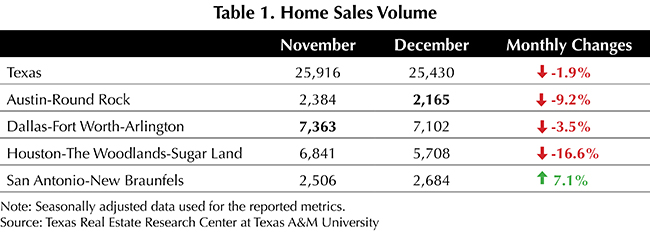
The state's average days on market (DOM) have increased to 57, marking the first uptick since April. This rise signals a potential trend towards longer listing times. All major metros witnessed increases in DOM, notably Houston (50 days) and Dallas (49 days), which rose by seven and four days, respectively. Austin (77 days) and San Antonio (68 days) showed minor fluctuations from the previous month.
Although housing supplies remained high, active listings fell for the first time since May, reaching 103,395 listings. Among the Big Four, only San Antonio (12,254) posted a monthly increase of 1 percent. Austin experienced the largest drop in active listings, with a 13.3 percent loss to 8,307 listings. Dallas (22,056) and Houston (24,770) had moderate reductions. Despite the decline in active listings in December, levels are still in line with 2019.
New listings in the state fell by 1.89 percent to 42,658 in December. All major metros recorded monthly decreases ranging from 2 to 4 percent. Austin saw a 2 percent decrease to 3,766 listings, while San Antonio had the largest decrease at 4 percent. Despite the fall in active listings, the months of inventory (MOI) experienced a slight decrease to 3.6, with Austin contributing significantly to the decline, dropping over 10 percent.
Decreasing Mortgage Rates
Mortgage rates continued their descent, with treasury and mortgage rates falling amidst speculation that interest rate hikes are concluded. The ten-year U.S. Treasury Bond yield dropped 48 basis points to 4.02 percent. Similarly, the Federal Home Loan Mortgage Corporation's 30-year fixed-rate fell 62 basis points to 6.82 percent. If rates continue to decline into the start of 2024, housing affordability is expected to improve.
Permits remained unchanged, but construction starts saw an increase. Texas' single-family construction permits experienced a slight decrease of just under a quarter of a percent from November, totaling 12,392 issuances. Dallas and San Antonio had monthly dips of 5.3 percent and 12.9 percent, respectively. Houston and Austin showed minor fluctuations of less than ten issuances.
Construction starts increased by 2.5 percent month over month to 12,222 units in Texas. Despite the overall increase, San Antonio (8,08 starts) reported the only monthly increase among the Big Four, rising by 20.6 percent. Austin (1,392 starts) fell by 13.6 percent, causing the ratio of Austin to San Antonio starts to fall below the typical 2:1 ratio. Dallas (3,250 starts) and Houston (3,448 starts) continued to outperform the rest of the state, combining for 55 percent of total starts.
The state's year-to-date total single-family starts value increased to $29.8 billion, up from $27.7 billion in November. Starts values have mirrored 2019 values since May, although the value fell just outside the $1 billion threshold in December. Houston and Dallas accounted for over 60 percent of the state's construction value.
Median Home Prices Fall Despite Big Four Rising
Despite a rise in the Big Four, Texas' median home price fell by 0.7 percent to $332,300. Dallas was the only metro area to see a decrease, falling by 1 percent. Austin experienced the greatest price boost, with a 4.2 percent gain, reaching its highest level since January. Home prices across the Big Four remain above pre-COVID levels.
The state's average days on market (DOM) climbed to 57, marking the first increase since April. This increase suggests longer listing times could be approaching. All four of the major metros experienced increases in DOM with Houston (50 days) and Dallas (49 days) rising by seven and four days, respectively. Austin (77 days) and San Antonio (68 days) had minor fluctuations from the previous month.
Housing supplies remained elevated, but active listings fell for the first time since May, falling to 103,395 listings. San Antonio (12,254) was the only one of the Big Four to post a monthly increase at 1 percent. Austin had the largest drop in active listings with a 13.3 percent loss to 8,307 listings. Dallas (22,056) and Houston (24,770) had moderate reductions. Despite the fall in active listings in December, levels are still on pace with 2019.
The state's new listings fell 1.89percent to 42,658 in December. All four of the major metros posted monthly decreases of between 2 and 4 percent. Austin had a 2 percent decrease to 3,766 listings while San Antonio had the largest decrease at 4 percent. Amid the fall in active listings, the months of inventory (MOI) experienced a small decrease to 3.6 with Austin contributing heavily to the fall, dropping over 10 percent.
Construction starts grew while construction permits remained effectively unchanged, according to data from Dodge Construction Network. Single-family starts increased 2.5 percent MOM to 12,222 units. Despite the Texas increase, San Antonio (8,08 starts) reported the only monthly increase among the Big Four, rising 20.6 percent. Austin (1,392 starts) fell 13.6 percent, making the ratio of Austin to San Antonio starts fall under the typical 2:1 ratio. Dallas (3,250 starts) and Houston (3,448 starts) continued to outperform the rest of the state, combining for 55 percent of total starts.
The state's year-to-date total single-family starts value climbed to $29.8 billion, up from $27.7 billion in November. Starts values continued to mirror 2019 values since May, however, value fell just outside the $1 billion dollar threshold in December. Houston and Dallas accounted for over 60 percent of the state's construction value.
Texas Home Prices Fall
Texas' median home price fell 0.7 percent to $332,300 (Table 2). Among the Big Four metro areas, Dallas posted the only decrease, falling by 1 percent. Austin saw the greatest price boost with a 4.2 percent gain, raising the price to its highest level since January. Home prices across the Big Four remain above pre-COVID prices.
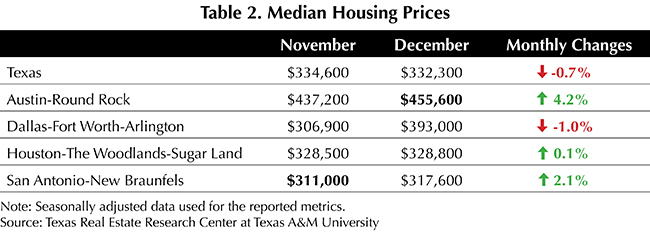
Home prices continued to hover around $200,000-$300,000 and $300,000-$400,000, accounting for 26 and 24 percent of total home sales, respectively.
The Texas Repeat Sales Home Price Index (Dec 2004=100) fell 0.9 percent MOM but remains 2 percent up from the previous year. Houston had the highest annual appreciation at 2.6 percent YOY increase while Austin showed the lowest annual appreciation at negative 3 percent.

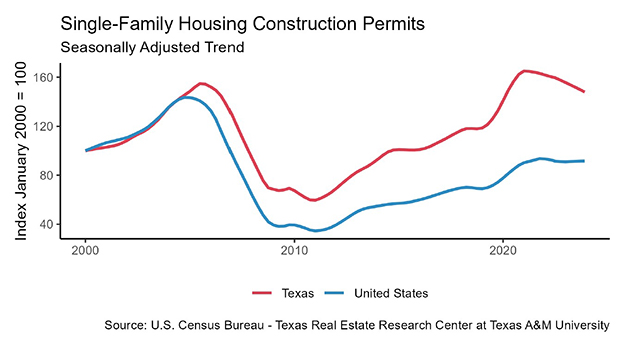
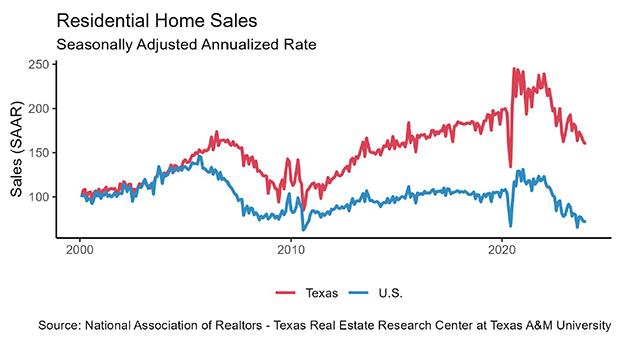
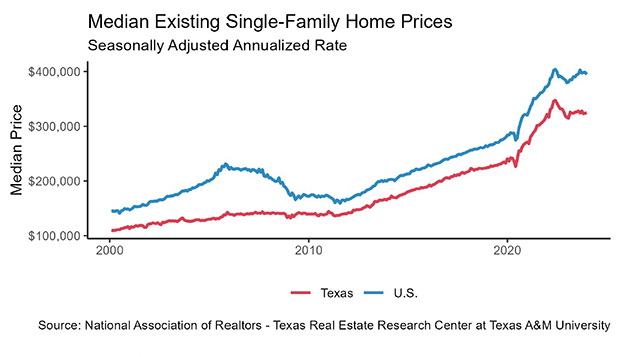
- Justin Brickman
- [email protected]
- 210-827-6020
